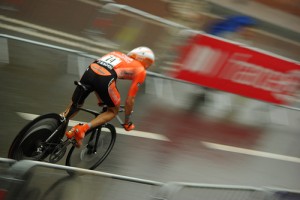Recently I talked about the importance of alternative training for beginners and how it can help prevent injury and build a larger endurance base. What I didn’t mention is that this tactic is also really important for every runner, even veteran marathoners or post-collegiate athletes.

I received a few notes from readers explaining that they have used cycling or swimming to help with their running. This strategy works. It’s not only great for fitness, but can be used in place of running to help with residual soreness or when you are nursing an injury.
Adding a few cross-training workouts to your weekly schedule will have a huge impact on your overall fitness and can dramatically reduce your risk of injury. I have used this tactic before to bring my running performances to the next level.
While going on the elliptical or pool running is great for my running, I actually hate both of these forms of exercise. They’re boring! And the elliptical seems so unnatural and awkward.
I prefer more purist forms of exercise and having a goal that I can work toward. I like training for triathlons.
Triathlon Training and Running
Why should you train for a triathlon if you’re a runner? Shouldn’t you just run all the time? The short answer is NO for almost every runner. By dedicating time to triathlon training and not just running, you’ll become a better athlete. And as Coach Jay Johnson always says, “To be a better runner, you must first be a better athlete.”
Triathlon training will help you:
- Build a larger endurance base by being able to exercise more.
- Reduce your injury risk.
- Work muscles you don’t typically use during running.
- Become a more well-rounded athlete as you learn how to swim and cycle.
- Run more when you finishing a triathlon training cycle.
It’s true that you will actually run less when you’re doing this training. But don’t worry, that won’t slow you down. During my own triathlon preparation, I was running about half of what I normally ran in training!
But it didn’t slow me down at all. In fact, I raced faster on the run leg of the tri even after swimming and biking. I placed 35th in my last triathlon, but my run was ranked 1st – a fast 5:16 per mile average over 2.9 miles after a tough bike leg (see the results for yourself).
After my three months of triathlon training, I transitioned back into running full-time. My running was at a new level thanks to the tri work – I raced a tough 10k XC race in 33:41, much faster than I thought I was going to run. I PR’d in the mile, running 4:33, and had a long period of hard training uninterrupted by injuries.
I had built up an enormous amount of aerobic strength by devoting time to triathlon training. Long rides of over 2 hours and intense swimming sessions gave me the strength to run more with less injury risk. Swimming and biking don’t beat you up like running does because they’re zero impact exercises.
I was able to dominate training and ran my first 10 mile race in 54:50. I closed the last mile in 5:09 and surprised the hell out of myself. I ran 73:39 in my debut half-marathon (about a minute faster than I thought was possible).
I was ecstatic about my new fitness and the training that I was able to do. Even during the following months, I kept cycling once a week to add an extra hour or two of aerobic work. Strategic cross-training had me convinced it can help runners reach new fitness breakthroughs. Are you ready for one of your own?
How to Train for a Triathlon
Training for a tri is difficult – you’re preparing for three different sports at the same time. Technique is very important in swimming and cycling can be technical. Even with that said, enjoy being in the water, riding your bike, and getting a break from running so consistently.
Admittedly, I am a runner who has dabbled in triathlon. I’ve read one triathlon training book and know a lot more about cycling than swimming. I actually don’t like swimming very much, even though I know it can get you in ridiculous shape (just look at Michael Phelps).
Enter Patrick McCrann. Patrick is the genius behind Fuel Your Endurance Lifestyle, a site helping triathletes and endurance athletes fit their training into their already busy lifestyle. Recently I did an interview with him highlighting Strength Running and my own struggles with injuries in the past (thanks for the interview Patrick!).
Patrick is a three-time IronMan World Championships qualifier (with a ridiculous PR of 10:04) and has twice qualified for the Boston Marathon. He’s not just a triathlete, but also a runner, which I think makes him uniquely valuable and knowledgeable to the readers here at Strength Running.
Patrick has put together the most comprehensive triathlon resource available that is perfect for runners who want to make a temporary (or permanent…don’t worry, I won’t be upset) transition to triathlon: his value-packed book Competitive Triathlon in 10 Hours a Week.
I’m jacked up about this book because it dispels conventional wisdom about tri training and lays it out there – so you won’t be wasting your time. Patrick has an outlook on training that is similar to mine; do the stuff that matters and don’t forget to live your life!
If you want to vary your training, attempt a triathlon but don’t know where to start, or are worried you won’t be able to fit all the training into your schedule, learn more about Competitive Triathlon in 10 Hours a Week. Patrick is someone I trust and this resource over delivers on value. It will make you a better runner.
Photo Credit